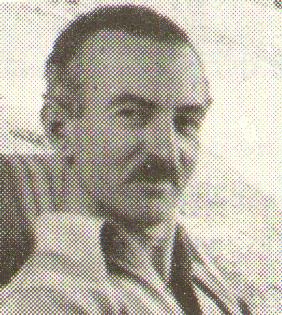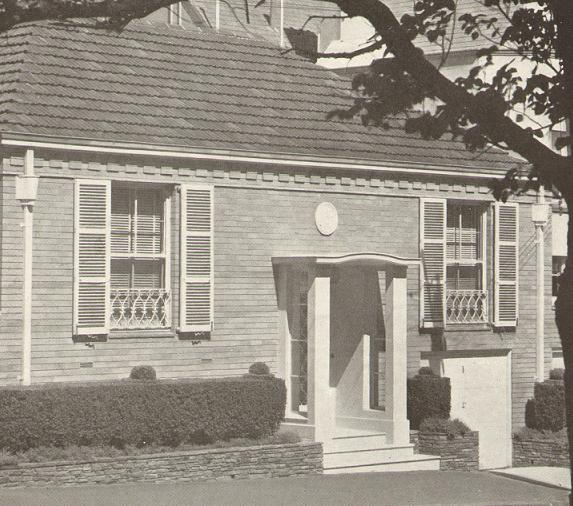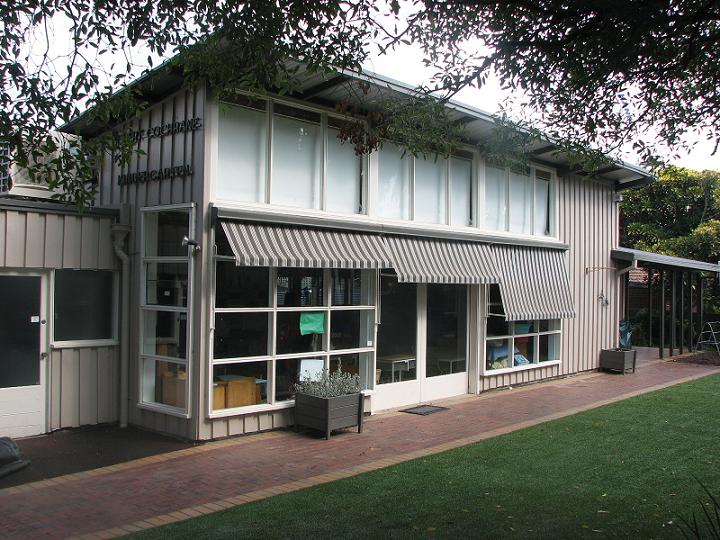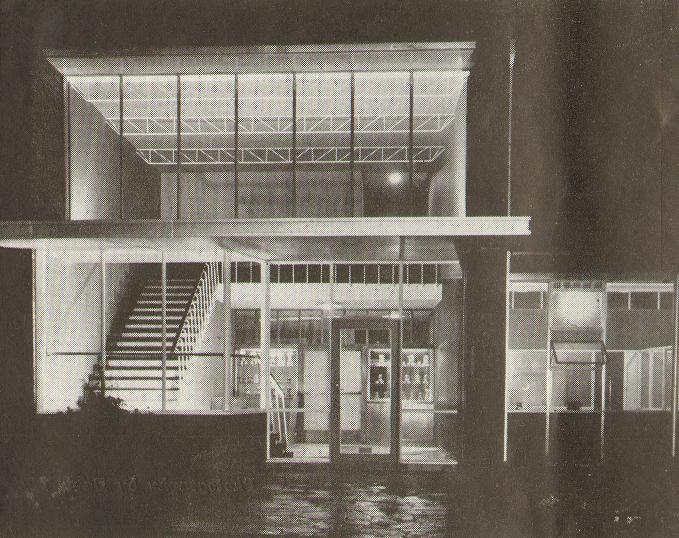Born in 1908, Horace
James Tribe commenced his architectural career in 1924
as an articled pupil of H W & F B Tompkins, who were then involved
in such major city projects as the Herald
building and the expansion of the Myer department store. Tribe
also studied at the Swinburne Technical College
and the University of Melbourne Architectural Atelier, where
he completed a Diploma of Architectural Design in 1930. He then
took up a position with prominent modernists Stephenson & Meldrum,
where he worked in both the Melbourne and Sydney offices
on large hospital and industrial projects as well as the Spirit of Progress locomotive
fitout. During that period, he also worked in Melbourne as a
relieving draftsman for other firms, including Oakley & Parkes
(later marrying Percy Oakley's only daughter, Florence, in 1935) and
Hudson & Wardrop. In 1933, the young Tribe won a design
competition for a house to cost £850; the following year, when he was
admitted to the RAIA, Tribe narrowly missed out on winning the
inaugural Robert & Ada Haddon Travelling Scholarship.
In November 1938, Tribe entered into partnership with the prominent society architect Marcus Martin (1892-1981). Styled as Marcus Martin & Tribe, the firm initially specialised in the sort of high-class residences (mostly in Toorak and South Yarra) that had characterised Martin's pre-War career; four fine examples later appeared in George Biers' Houses of Australia (1948). Martin & Tribe also fostered an interest in buildings for social welfare, and specifically an association with the Free Kindergarten movement. This began with a commission to design the prototypical Lady Gowrie Childcare Centre in Carlton (1939) and led on to several other suburban kindergarten projects. During the period 1938-39, Horace Tribe also served as Honorary Director of a committee established to increase public awareness of a better standard of residential architecture in Victoria. The work of this committee was interrupted by the Second World War and did not resumed until 1947, when it resulted in the creation of the celebrated Small Homes Service of the RVIA, with Robin Boyd as its first Director.
The Second World War also interrupted the partnership of Marcus Martin & Tribe. The latter partner enlisted with the RAAF in May 1942 and served at Station HQ, Laverton, until he was discharged, with the rank Flight Lieutenant, in August 1945. He then worked as a technical adviser to the Commonwealth Directorate of Housing before re-joining Marcus Martin in private practice. He was evidently elevated to the status of full partner, as the firm was subsequently known simply as Martin & Tribe. The reunion, however, proved short-lived, as the partnership was dissolved in mid-1949 when Tribe resigned to open his own office. Outstanding commissions that had been received by the partnership were subsequently divided amongst the two men, who completed them under their own names: Martin finished off the Gordon Boys' Home in Highett and two kindergartens in Burwood and Fitzroy, while Tribe carried on with the Robert Cochrane Kindergarten in Auburn and some additions to a holiday camp in Ringwood East. On completion, the former project was much lauded in the press as a prototype for truly modern kindergarten design in Australia; it was included in D C Ward's Guide to Victorian Architecture, and was even published overseas in the pages of the US-based Architectural Forum. In his newly-launched sole practice, Horace Tribe went on to become the state's leading specialist in the design of modern pre-school centres, with examples as far afield as Swan Hill and Korumburra.
In 1955, it was noted in Architecture & Arts journal that Tribe maintained "an extensive practice in pre-school and preventive health services, good quality domestic work and industrial buildings". During this period, he also served as architect to the South Melbourne City Council, in which capacity he undertook various projects include the design of a children's play centre and the remodelling of the public library and the Trugo Club premises. During this peak period of his career, Tribe was also very active in professional bodies, serving as vice-president of the VASS and as Chairman of Committees to the RVIA Council. In 1953, he was one of more than 2,000 prominent Victorians to be awarded the Queen's Coronation Medal for their services to the community.
Horace Tribe retired from active practice around 1970, but he maintained his registration as an architect until his death in 1992. In retirement, he compiled a memoir of his role in the development of the Small Homes Service, entitled The Small Homes Service of the RVIA: Some Recollections of its Genesis and Establishment.
In November 1938, Tribe entered into partnership with the prominent society architect Marcus Martin (1892-1981). Styled as Marcus Martin & Tribe, the firm initially specialised in the sort of high-class residences (mostly in Toorak and South Yarra) that had characterised Martin's pre-War career; four fine examples later appeared in George Biers' Houses of Australia (1948). Martin & Tribe also fostered an interest in buildings for social welfare, and specifically an association with the Free Kindergarten movement. This began with a commission to design the prototypical Lady Gowrie Childcare Centre in Carlton (1939) and led on to several other suburban kindergarten projects. During the period 1938-39, Horace Tribe also served as Honorary Director of a committee established to increase public awareness of a better standard of residential architecture in Victoria. The work of this committee was interrupted by the Second World War and did not resumed until 1947, when it resulted in the creation of the celebrated Small Homes Service of the RVIA, with Robin Boyd as its first Director.
The Second World War also interrupted the partnership of Marcus Martin & Tribe. The latter partner enlisted with the RAAF in May 1942 and served at Station HQ, Laverton, until he was discharged, with the rank Flight Lieutenant, in August 1945. He then worked as a technical adviser to the Commonwealth Directorate of Housing before re-joining Marcus Martin in private practice. He was evidently elevated to the status of full partner, as the firm was subsequently known simply as Martin & Tribe. The reunion, however, proved short-lived, as the partnership was dissolved in mid-1949 when Tribe resigned to open his own office. Outstanding commissions that had been received by the partnership were subsequently divided amongst the two men, who completed them under their own names: Martin finished off the Gordon Boys' Home in Highett and two kindergartens in Burwood and Fitzroy, while Tribe carried on with the Robert Cochrane Kindergarten in Auburn and some additions to a holiday camp in Ringwood East. On completion, the former project was much lauded in the press as a prototype for truly modern kindergarten design in Australia; it was included in D C Ward's Guide to Victorian Architecture, and was even published overseas in the pages of the US-based Architectural Forum. In his newly-launched sole practice, Horace Tribe went on to become the state's leading specialist in the design of modern pre-school centres, with examples as far afield as Swan Hill and Korumburra.
In 1955, it was noted in Architecture & Arts journal that Tribe maintained "an extensive practice in pre-school and preventive health services, good quality domestic work and industrial buildings". During this period, he also served as architect to the South Melbourne City Council, in which capacity he undertook various projects include the design of a children's play centre and the remodelling of the public library and the Trugo Club premises. During this peak period of his career, Tribe was also very active in professional bodies, serving as vice-president of the VASS and as Chairman of Committees to the RVIA Council. In 1953, he was one of more than 2,000 prominent Victorians to be awarded the Queen's Coronation Medal for their services to the community.
Horace Tribe retired from active practice around 1970, but he maintained his registration as an architect until his death in 1992. In retirement, he compiled a memoir of his role in the development of the Small Homes Service, entitled The Small Homes Service of the RVIA: Some Recollections of its Genesis and Establishment.
Select List of Projects
Martin & Tribe (1946 to 1949)
| 1946 1947 1948 1949 | Residence, Belmore Road, Balwyn North Gordon Boys' Home, Port Nepean Road, Highett Additions to Kindergarten Training College, Kew Pre-School Centre for Victorian Deaf & Dumb Institution, Elgar Road, Burwood Group housing for ARC Corporation, Albion Free Kindergarten & Infant Welfare Centre for City of Port Melbourne, Fishermens Bend Residence for Mrs E S van Staten, Anderson Street, South Yarra Residence for Mrs H F Creswick, Albany Road, Toorak Residence for K Syme, Lisbuoy Road, Toorak Residence for D S McKinnon, Beaufort Isabel Henderson Free Kindergarten, Green Reserve, Fitzroy Alterations and additions to Ware Holiday Home, Ringwood East |
Horace J Tribe (1949 onwards)
| 1949-50 1950 1951 1953 1954 1955 1958? 1959 1960 1962-63 | Robert Cochrane Free Kindergarten, Minona Street, Auburn Colac Free Kindergarten, Gilmartin Street, Colac Playroom at Yooralla Hospital School Balwyn Road, Balwyn Residence (for self?), Springvale Road, Mitcham Residence, Keam Street, Ivanhoe Residence, Kidds Road, Dandenong Manager's Residences for ES&A Bank, Blackburn and Mitcham Residence, Beleura Hill, Mornington Residence, Tarrawarra Ringwood Free Kindergarten, Greenwood Avenue, Ringwood Deepdene Park Free Kindergarten, Deepdene Pre-School & Infant Welfare Centre, Splatt Street, Swan Hill Pre-School & Infant Welfare Centre, Victoria and Bridport Sts, Daylesford Alys Key Emergency Nursery, Forest Hill Hughesdale Free Kindergarten, Freda Street, Hughesdale Pre-School and Infant Welfare Centre, Victoria Street, Korumburra Alterations to South Melbourne General Library, South Melbourne Pre-School & Infant Welfare Centre, Richardson and Nimmo Streets, Middle Park Children's Play Centre for the City of South Melbourne Office and warehouse for J C Hutton Pty Ltd, 65 High Street, Preston [demolished] Remodelling of premises for South Melbourne Trugo Club, Howe Cres, South Melbourne Office building for L & H Lasky Pty Ltd, 62 Lygon Street, Carlton [demolished] Flats for Elann Pty Ltd, Pleasant Road, Hawthorn Foreshore redevelopment (ablution blocks, clubrooms) for City of South Melbourne |
 | |
| Horace Tribe in the early 1950s |
 | |
| Group housing for ARC Corporation, Albion (1947) |
 | |
| Mrs E S van Staten Residence, South Yarra (1948) |
 | |
| Robert Cochrane Free Kindergarten, Auburn (1949-50) (photograph by Simon Reeves, Built Heritage Pty Ltd) |
 | |
| J C Hutton Factory, High Street, Preston (1955) |
